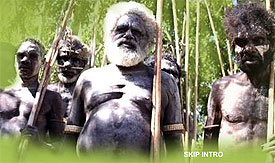David Gulpilil, the leading aboriginal actor (Crocodile Dundee, Rabbit-Proof Fence) had been badgering de Heer to make a film about his people. De Heer had a window in his schedule so he agreed.
At first Gulpilil wanted to do a romance about a doomed aboriginal couple whom the whites wipe out in the end. De Heer encouraged him to think of something else. Gulpilil came back with a photo of ten aborigines in canoes and said, "We need ten canoes." Ethnographer Donald Thomson had taken the photo and 11,000 others in the 1930s, when the aboriginal culture was still largely untainted. De Heer said the Australian equivalent of "Eureka!" and that was it.
Trouble in paradise
But they didn't know what awaited them. For starters, the aborigines of the region, Arnhem Land, had completely lost their traditional culture and were living in a small town. They had little or no idea how to make canoes from tree bark. De Heer had to show them Thomson's photos and drawings of canoes before they could figure out how to do it.
When it came time to film, De Heer said they had only two of ten canoes, 30 instead of 300 spears, and half the cast. The aboriginal actors didn't quite grasp the concepts of rehearsals and multiple takes. They had problems with the nudity required.
Filming on the water meant avoiding crocodiles, leeches, and mosquitoes. Things went more smoothly on dry land except for a few near-mutinies. One traditional old man refused to pretend he was married to three women of the wrong clans and left. He came back only when they got another actor for the husband role.
Worth the hassles
Fortunately, the results are impressive in terms of authenticity. Several scenes are near matches for the old Thomson photos. When you get a ringer in a Native film, you can often tell--e.g., Wes Studi playing the Apache Geronimo or Adam Beach playing the Navajo Jim Chee. But you'd never guess these aborigines were basically divorced from their ancestral culture. They looked and acted as if they'd been living traditionally for decades, not days.
This attention to detail is why people believe movies. And people tend to love what they believe. That's why historical accuracy is important in indigenous movies (or any movies with historical themes).
Ten Canoes also gave something back to the aborigines. Not only did it remind them of their traditional culture and language, but it renewed their sense of pride. After participating in the movie, they learned to stand up for and speak more confidently about things. "In strengthening their cultures, they strengthened themselves," concludes the narrator.
For more on the subject, see The Best Indian Movies.


No comments:
Post a Comment